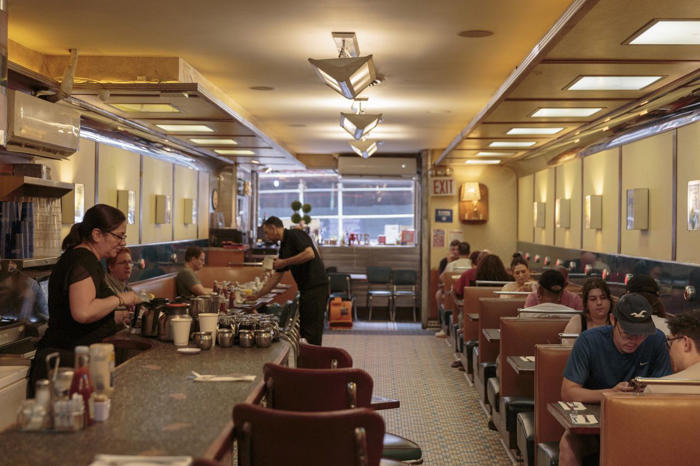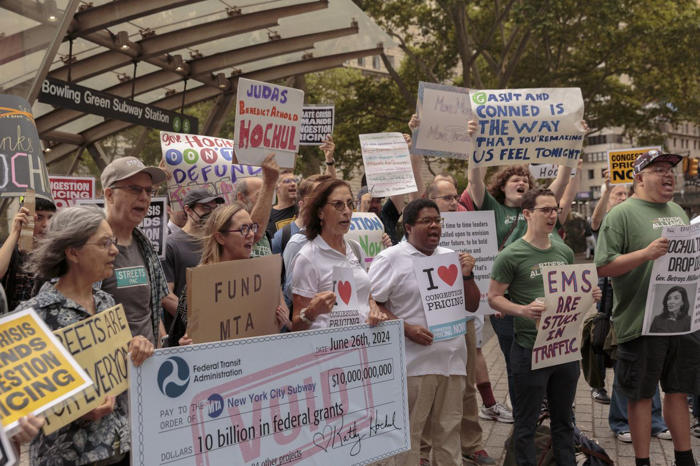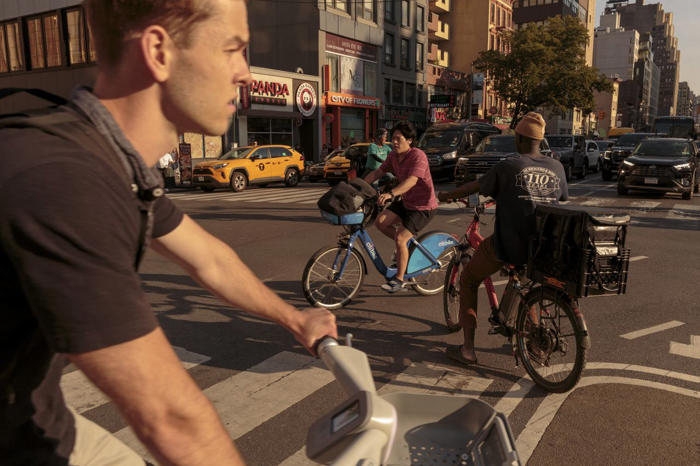17 Years, $700 Million Wasted: The Stunning Collapse of New York’s Traffic Moonshot
NEW YORK—Patrons at the Comfort Diner in Midtown Manhattan recently encountered an unexpected person working the tables: Gov. Kathy Hochul.
Rather than take orders, she went booth to booth seeking opinions about the city’s first-in-the-nation plans for congestion pricing—a $15 toll on vehicles entering the core of Manhattan.
Nobody realized at the time that the Democratic governor was heading toward a blockbuster announcement: she was about to scrap the program after years of planning and hundreds of millions of dollars spent. In one of the most consequential decisions in decades for America’s most prominent city, Hochul soon said she was indefinitely pausing congestion pricing—less than a month before it was set to take effect on Sunday, June 30.
The abrupt reversal, which some attribute to Hochul’s reluctance to impose a new fee in an election year, leaves metro New York grappling with a historic missed opportunity and fiscal mess. There is no relief in sight for the city’s traffic congestion, which is the worst in the world, according to data published last week.
The epic collapse in New York shows how a fear of dramatic change can give the status quo stubborn power over those trying to solve some of America’s most intractable challenges. That leaves policymakers nibbling at the edges of deeply rooted problems, even after investing huge sums of money and political capital.
Blown up in a New York minute were plans for around $15 billion of planned improvements to the city’s ailing mass-transit system, the largest transportation network in North America. The reversal cast aside around $700 million in meticulous prep work, including a $555-million contract to install tolling cameras—which are already up and ready to go—and $33 million for a customer-service center with 100 employees who have already been brought on, officials said. Planners invested thousands of hours, including going to London and Stockholm to research their congestion-pricing programs, according to people familiar with the travel.

What was supposed to be a transformative moment when New York led the way and boldly tackled traffic congestion, air pollution and transit funding, has instead turned into a surprising loss for a broad coalition that includes major employers, real-estate developers and subway riders.
Surprised by the reversal were Hochul’s own lieutenants, including Janno Lieber, a fierce champion of congestion pricing and the chief executive of the Metropolitan Transportation Authority. The MTA—which carries around 5.5 million passengers each day in the New York metro area—now faces a $16.5 billion-financial hole from the loss of money from congestion pricing and federal matching funds.
Just days after Hochul’s announcement, a beleaguered Lieber joined a conference call with advocates in which he said he was equally shocked and remained committed to the program, three people familiar with the exchange said.
“This is devastating,” he said, according to a person on the call.
This account of the rise and fall of congestion pricing is based on interviews with more than two-dozen officials, advocates and lawmakers who were involved in its development. While they were mixed on the merits of the program and whether Hochul was right to delay it, nearly all were astonished by the suddenness of her decision and how hastily it was rolled out.
A big idea
Notable New Yorkers had long pushed to join global cities—including London, Stockholm and Singapore—that are battling gridlock through congestion pricing. The general concept is simple: install cameras at key entry points and charge drivers to enter busy metro centers. This aims to boost alternative or public transportation, cut pollution, improve health and fund transit infrastructure—making it more feasible to use it.
Then-Mayor Michael Bloomberg, a billionaire technocrat, first put it on the table in 2007 when he included congestion pricing on a list of items he felt could make New York more sustainable as the city’s population was surging.
He pointed to London, which adopted congestion pricing in 2003. In a report the next year, officials there said the number of cars entering the congestion zone fell 18%, the amount of particulate matter in the air declined by 12%, more people rode buses and bus speeds increased by 6%.
Advocates in New York also noted that while there was some initial opposition in London, it dissipated as people felt the full effects.
But Bloomberg hit a brick wall at the state capitol in Albany, recalled David Weprin, an opponent of the plan. Weprin is a veteran elected official in eastern Queens, where many residents, such as himself, live more than a mile from the nearest subway stop.
“You can take a bus to the subway, but it often takes an hour and a half to get into Midtown Manhattan,” he said. “Driving, as bad as traffic can be, is still less than an hour.”
Lawmakers representing New York City’s outer-boroughs and suburbs banded together to kill the proposal. Bloomberg left City Hall, but in 2010, Andrew Cuomo was elected governor—and grabbed the congestion-pricing baton.
Cuomo, raised near Weprin in Queens, grew up tinkering with muscle cars. The MTA wasn’t an immediate priority after his 2011 inauguration. Soon, though, he drove the authority toward ambitious infrastructure projects—even if that meant less emphasis on routine upkeep.
That became a political problem in 2017, when train delays plagued the city, sparking national news and the so-called “Summer of Hell.” Cuomo launched a maintenance blitz, and the MTA tapped Andy Byford to run the faltering subway system.
Byford, a compact Brit, started his career at the London Underground and brought firsthand experience living with congestion-pricing. He resided in central London when that city began the program, and he witnessed the benefits: traffic fell, and officials were able to start upgrading rail and bus service. After winning a third term in 2018, Cuomo embraced the idea. Byford went to the state Capitol to persuade lawmakers.
In 2019, victory came when New York lawmakers finally passed congestion pricing as part of the state budget. Supporters hailed it as a model for the nation.
“This is the most transit-rich part of the entire country,” said Julie Tighe, president of the New York League of Conservation Voters, an environmental group. “We know that people in other parts of the country are looking to us to see what can be done to address traffic.”
Spending and prep
At the MTA, the vote was a starting gun. Janno Lieber, the current MTA chief, then helmed the agency’s capital program and quickly pounced on the project. The former real-estate executive had helped orchestrate the rebirth of the World Trade Center. With his boyish grin, blond hair and often purple tie, Lieber dove headfirst into congestion pricing.
MTA staff started making trips to Washington to discuss what kind of environmental review would be required under federal law, remembered Midori Valdivia, who was brought on in 2018 as chief of staff to the chairman. She recalled early talk about how including the word “pricing” in the title made it more difficult to communicate the program’s goals of reducing traffic and improving transit. It came to naught.
Meanwhile, New York City’s Transportation Department, which also helped with the planning, dispatched its own team. Employees went in 2019 to London and Stockholm to research how those cities’ congestion-pricing systems worked, according to people familiar with the travel.
The MTA signed its first contracts that year. The largest grew to about $555 million to erect and run the toll cameras and gantries, according to MTA documents. Tennessee-based TransCore finished that work in May of this year. Not all of that money has been spent, and it is unclear if the authority will be able to exit from the contract, a spokesman said.
That was just one part. MTA documents also indicate the authority poured about $97 million into initial study and environmental-review work. More than 600 people contributed to the planning and approval efforts, according to Allison C de Cerreño, the MTA official who oversaw it. The environmental review stretched to more than 45,000 pages, according to a summary included in recent court papers.
Beyond the $555-million contract and $97 million outlay, MTA documents show the authority paid $6 million to other public agencies that worked on the program. The MTA also spent $33 million on a customer-service center, for which an official said roughly 100 people have been brought on board. (Their jobs are on hold, the official said.)
The public was also weighing in: 1,800 people spoke at public hearings in August of 2022, and officials received 70,000 comments on their plan.
In May of 2023, when New York’s congestion-pricing plan won approval from the federal government, Gov. Hochul’s office trumpeted a momentous victory for a program that “will benefit millions of people every day.” A news release blared: “Governor Hochul Announces First-in-Nation Congestion Pricing Will Move Forward, Improving Air Quality and Reducing Traffic.”
That step also prompted lawsuits, which alleged the federal government should have conducted a more extensive review. Plaintiffs included Manhattan-bound drivers, the head of the local teachers union and the state of New Jersey, where Gov. Phil Murphy has complained Garden State commuters already paid tolls to use bridges and tunnels to enter Manhattan. (A federal judge on June 20 partially dismissed some of the suits.)
Lieber, however, held firm through it all, and Hochul backed him up. As recently as December 2023, she appeared at a rally with advocates in Union Square.
“Anybody sick and tired of gridlock in New York City? Anybody think we deserve better transit?” Hochul said as the crowd roared its approval. “Well then you love congestion pricing, right?”
Frustration was rising. The typical driver in New York lost a staggering 101 hours to traffic jams in 2023, up 11% from 2019, according to Inrix, a transportation-research firm.
The MTA board approved the toll amount of $15 in March of this year, and the authority said it would turn on the cameras on June 30. According to estimates, about 100,000 fewer vehicles daily would enter the core of Manhattan as a result.
Cold feet
Gov. Hochul, though, was hardly at the peak of her power. She had a closer-than-expected race against a Republican challenger in her 2022 election, and lost both counties on Long Island—considered key bellwethers. Democrats that year lost their House majority in part because of GOP gains in New York.
Hochul’s signature proposal in 2023—to encourage housing in part by allowing for an end-run around local zoning—was rejected and stirred more trouble in the suburbs. She became increasingly sensitive to the concerns of voters in suburban swing areas in 2024, people who spoke to her said, intent upon not suffering the same fate as in 2022.
A poll released in April showed the lawsuits and complaints about congestion pricing were moving public opinion: 63% of registered voters surveyed said they opposed congestion pricing versus 25% who supported it.


“She had been concerned about the timing of this for a very long time,” said New York state Democratic Committee Chairman Jay Jacobs. “She’s always felt that if we do congestion pricing, it is got to be a time when people can deal with it.”
Hochul privately shared her unease with top state lawmakers, but she didn’t say she was planning to reverse course, they and their aides said. At one point, a couple of months ago, Hochul told Kathryn Wylde, the head of the business group Partnership for New York City, that she was hearing concerns from constituents about the financial impact on commuters, Wylde said.
“‘You need to do a better job of advertising the benefits,’’ Wylde recalled the governor saying. “She was right.”
The governor brought up the idea of a temporary pause in conversations with House Minority Leader Hakeem Jeffries, a Democrat from Brooklyn who has also been focused on winning elections in the New York suburbs, people familiar with their conversations said. Jeffries said he was supportive.
And Hochul spoke with people in public places, including the Comfort Diner. She heard concerns about yet another rising cost, the diner’s owner said.
She didn’t give a heads-up to people she had stood with at that December rally. Members of the MTA board—including her own appointees—said they weren’t notified. Lieber only got official word a few hours before the first late-night press reports, he said.
The summer of ugh
Lisa Daglian, executive director of the Permanent Citizens Advisory Committee to the MTA, learned about the governor’s reversal from early-morning news reports. “It’s almost like, OK, it is a bad dream,” she recalled. “When am I going to wake up?”
Hochul released a video announcement from her office that morning, June 5, saying in part that “circumstances have changed.”
“I cannot add another burden to working- and middle-class New Yorkers—or create another obstacle to continued recovery,” she said.
Daglian rushed from the MTA’s headquarters to midtown to join an impromptu protest outside Hochul’s office. She saw Byford, the former subway chief who is now an official at Amtrak. Byford wasn’t going to protest but was headed into the MTA’s lower-Manhattan offices for what was supposed to be a celebratory send-off for his successor Rich Davey, who is leaving to take a job in Boston.
Instead, the 30th-floor conference room where the luncheon took place was like a funeral, people familiar with the gathering said. Byford and other former transit leaders ate chicken, salad and ravioli. There was no alcohol to drown their sorrows.
A strange scene also unfolded at the state Capitol as Hochul and her aides floated proposals for how to make up the lost revenue from congestion pricing, just two days before lawmakers were set to adjourn for the year. The Hochul administration’s idea to raise taxes on businesses was quickly rejected, legislators and officials said. The next plan was “some kind of strangely worded three-sentence proposal” that was halfway between an IOU and a fiscal guarantee, recalled Democratic state Sen. Liz Krueger. It also wasn’t acted upon.
“There were just a lot of people just totally confused about why this was happening and how it could be happening,” Krueger said. “This was a huge mistake, and there isn’t going to be a good punchline unless she reverses herself.”
Lieber said nothing publicly for days. He was just as disappointed as many of the congestion pricing advocates, people who spoke with him said.
In the following week, MTA officials said they would stop working on the long-awaited Second Avenue Subway. The project had opened in 2017 and was due to be extended into East Harlem. On June 10, Lieber spoke out. Gone was the expansive talk of transformation. Now, faced with fewer resources, he said his new priority was “basic stuff to make sure the system doesn’t fall apart.”
A giant hole
Officials have begun puzzling over how to replace the $1 billion a year they planned to receive from the congestion tolls. It supported $15 billion of a $51.5-billion capital plan. The pause also threatens at least $2 billion in federal funding, which after accounting for the cost of running the congestion tolling system put the full impact at $16.5 billion, an MTA spokesman said. The advocacy group Reinvent Albany said this fiscal hole puts about 100,000 construction-related and manufacturing jobs at risk.
“It’s not just about what we can do in the future, it is undermining what we have already achieved,” said Danny Pearlstein, a spokesman for the Riders Alliance, a public-transit advocacy group that supports congestion pricing.
On Wednesday, protesters gathered outside an MTA board meeting in Manhattan, holding signs reading “New Yorkers Demand Congestion Pricing Now!” Pearlstein led the crowd in chants of “flip the switch, flip the switch!”
More than 100 people signed up to give public comments at the session. One was Jessica Scarcella-Spanton, a state senator from the outer borough of Staten Island, who was a rare supporter there of Hochul’s decision.

“Not only would this have a very detrimental effect on my constituents’ pockets in the cost of it, but the environmental issues are a major problem,” she said, noting traffic could shift outside the congestion zone. “It’s not right to place one borough over another.”
A poll released June 20 found 45% of voters supported Hochul’s decision to put congestion pricing on hold, compared with 23% who opposed it and 16% who were in the middle. But the same poll said Gov. Hochul’s approval ratings had fallen since May and were at an all-time low, with her favorability at 38%.
During the meeting, transit officials detailed the long list of projects that would have to be put off due to the halt of congestion pricing. The purchase of new subway trains and buses? Deferred, along with efforts to make subway stations more accessible. The replacement of 1930s-era subway signal systems on some train lines would also have to wait.
Hochul said in a statement that she is committed to finding another funding source for the capital improvements and “there is no reason for New Yorkers to be concerned that any planned projects will not be delivered.” Lieber said Wednesday he believes the pause is temporary and congestion pricing will eventually happen.
Meanwhile, traffic continues to crawl in Midtown Manhattan. New York City had the worst traffic congestion in the world in 2023, beating out major metropolitan areas such as Mexico City and London, according to Inrix.
Average traffic speeds in Midtown are the worst they have ever been, according to said Sam Schwartz, who has tracked traffic trends in the city since the 1970s. The average travel speed in Midtown fell to 4.5 miles an hour in May, the lowest ever recorded for the month. 2024, he said, is on pace to be the worst year ever for traffic congestion.

Write to Jimmy Vielkind at [email protected] and Joseph De Avila at [email protected]
